The Definitions of Tango
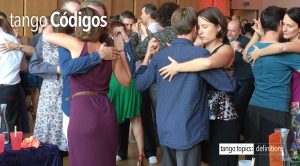
Definition: Códigos
the word Códigos in a very specific manner. We mean it as an all encompassing umbrella term for a set of actions that create the social context of how we engage and comport ourselves at, and within, the Milonga experience. Códigos can be, but is not limited to: How we enter a room, Who we talk to (or don’t), Where we sit and who we sit with,
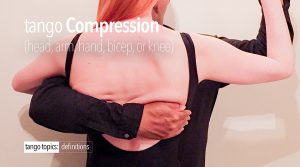
Definition: Compression
Tango Compression can best be defined in one of three ways. 1.) A constriction of the muscles of the knee, (or elbow) to build up ‘energy’ to be used to sustain a position, stance, and/or movement. 2.) A constriction of the muscles around the elbow, or hand (and wrist) which is used as an indicator to either start or stop motion. Typically this is used as a way to communicate clear intent from Lead/er to Follow. 3.) Laying one’s head onto the head of the partner, employing (unconsciously) the weight of their head onto their partners.
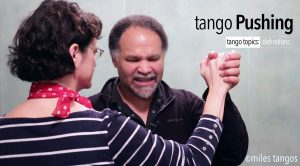
Definition: Pushing
Pushing. According to Webster’s Dictionary the word ‘Push’ is a verb that means “to exert force on (someone or something), typically with one’s hand, in order to move them away from oneself or the origin of the force”. It comes from the middle english word (1250 – 1300) ‘pushen’. Pushing is the adjective form, and generally means the same thing. Generally. 😉
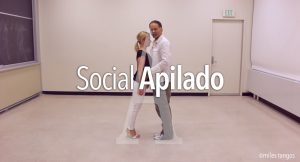
Definition: Apilado
Apilado (pron: Ahh-Pee-Lah-Do), this word is the past participle of the verb ‘Apilar’ which means ‘to pile up’ or ‘to put in a pile’. From a Tango perspective it means to put one’s body onto another, or to place your body onto another persons body. This style is the ‘iconic’ look of tango, the leaning bodies that form an "A" frame between the partners.

Definition: Encuentro
What is an Encuentro? The answer is multifaceted, and multilayered. The definition covers several areas: Frequency of dance. Style of dance. Códigos of dance. Floorcraft. Music and the Tango DJ. As well as the environment itself.
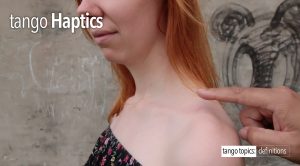
Definition: Tango Haptics
Usage: ‘Haptics’ ? You may have encountered this word in the technical world, when it comes to iPhones, as in “Haptic’ feedback. The word refers to the tactile, kinesthetic, and proprioceptive contact and feedback (the feedback part is very important) when manipulating an object.
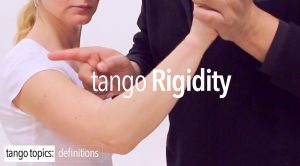
Definition: Tango Rigidity
Rigidity. (pron: rij-id-it-ee) According to Webster’s Dictionary the word ‘Rigidity’ is an adjective that means to be ‘stiff’ or ‘unyielding’, ‘not pliant’, ‘inflexible’, ‘strict’, ‘firmly fixed’, and or ‘set’. It comes from the latin word ‘rigidus’ meaning to be “stiff” or in its conjugated form to “stiffen”.
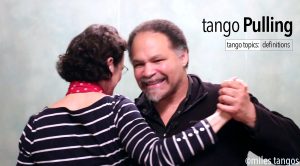
Definition: Pulling
Tango Pulling or Pulling in Tango occurs when we use both our arms as either a Lead or a Follow. In the case of the Lead, they may pull with their Left arm and hand, and/or at the same time with their Right hand, forearm, bicep. The Follower usually only pulls with their Right hand and arm.
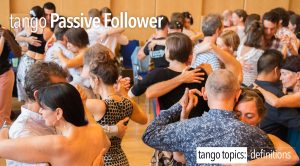
Definition: Passive Follower
Typically this phrase is used to describe a less than desirable Follower, when in reality the Passive Follower is a way of describing a noble state of Following and really what happens most of the time in the role of the Follower.
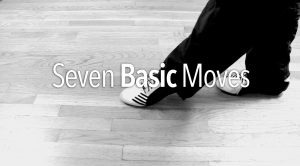
Definition: 7 Basic Moves
7 Basic Moves. There are seven basic moves to Argentine Tango from which the dance is derived. In order, and sequence, they are 1.) Forward Steps. 2.) Side Steps. 3.) Back Steps. 4.) Forward/Back Ochos (all 8 varieties included). 5.) Follower’s Giro/Lead Giro (all 8 varieties included)….
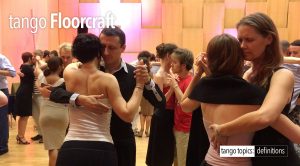
Definition: Floorcraft
‘Floorcraft’ is, but is not limited to: The active choice of, and execution of tango vocabulary (lead or follow) in time to the music (beat/pause/and phrasing), within the line and lane of dance, that does not impede the ronda, or the couples around the initiating couple (as a lead or follow), nor does it impact or endanger other couples. Instead, floorcraft as a practice works harmoniously within the embrace of the initiating couple, and then the couples around them, and co-exists peacefully within the ronda….

Definition: A ‘L/lead’
In Argentine Tango it is customary to use the word ‘Leader” to signify and identify the role of the dancer that is indicating direction, pace, timing, vocabulary choices, and musical interpretation to a degree.
